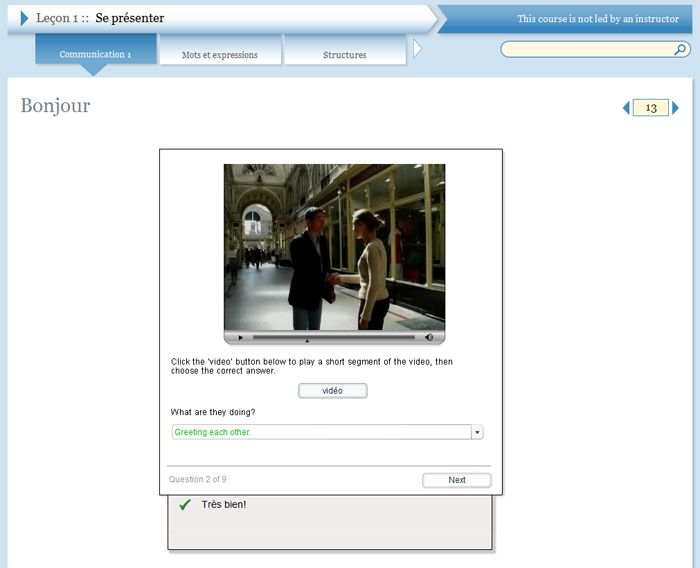Important dates
You can register in Beginner Chinese 1 — Instructor-Led for Independent Learners at any time through August 29, 2024.
- Start date: August 27, 2024
- End date: December 9, 2024
NOTE: Please visit the Zoom class schedule tab for information on your live Zoom meetings.
Zoom class schedule
Meet with your instructor and peers via Zoom:
- Tuesdays from 4-5pm Eastern Time (ET)
Use a time zone conversion tool to convert this to your local time.
What students will learn
By the end of this course, students will learn to:
- Distinguish the tones and use pinyin
- Greet someone in Chinese
- Introduce themselves
- Express their nationality and talk about their languages
- Describe themselves and their family members
- Make a short phone call in Chinese
- Describe their daily schedules
Learning objectives by module
Unit 1: Foundations
Module 1: Pinyin Intro
- Differentiate the four tones in Pinyin
Module 2: Palatal, Dental, and Retroflex Initials
- Recognize the difference in pronunciation for pinyin initials
Module 3: Compound Finals
- Distinguish the compound finals in Pinyin
Module 4: Nasal Finals
- Distinguish the nasal finals in Pinyin
Module 5: Special Pinyin Rules
- Describe the special pinyin rules for finals, initials, and tone changes
Module 6: Pinyin Review Exercises
- Distinguish the 6 vowels and 21 initials in Pinyin
- Determine the correct tone and syllable for a pronounced pinyin or phrase
- Articulate tongue twisters in Chinese with the provided Chinese characters and/or Pinyin
Module 7: Basic Chinese Expressions
- Use basic Chinese phrases for numbers and greetings
Module 8: Unit Test
Unit 2 Greetings
Module 9: Main Content
- Greet someone with the proper vocabulary and Chinese greeting customs
Module 10: Listening
- Identify the main topics discussed in a conversation
- Construct a logical conversation based on given sentences
Module 11: Grammar
- Explain one’s occupation and those of others
Module 12: Reading Exercises
- Identify the main topics discussed in a text
Module 13: Consolidation Exercises
- Provide the correct pinyin after listening to an audio excerpt
Module 14: Culture Link
- Make comparisons between Chinese-speaking cultures and one’s own culture
Module 15: Unit Test
Unit 3: Names
Module 16: Main Content
- Greet someone with the proper vocabulary and politeness of Chinese greeting customs
Module 17: Listening
- Construct a complete sentence based on an audio excerpt
- Translate the content of audio excerpts
Module 18: Grammar
- Formulate a conversation in Chinese about name, characteristics, and occupation
- Practice the proper usage of the particle 的
- Determine the correct plural pronoun to used based on the given point of view
Module 19: Reading Exercises
- Make an inference about someone based on the given text
- Intepret the meaning of a word based on a given text
Module 20: Consolidation Exercises
- Construct a logical conversation based on given sentences
Module 21: Culture Link
- Make comparisons between Chinese culture and one’s own culture of naming children
Module 22: Unit Test
Unit 4: Nationalities
Module 23: Main Content
- Employ the patterns of country name, nationality, and world languages in Chinese
Module 24: Listening
- Describe the main action in the given scenario
- Identify the relationship between different characters in a scene
Module 25: Grammar
- Determine the correct demonstrative pronoun based on context
Module 26: Reading Exercises
- Ask and answer questions in Chinese about a character or location
Module 27: Consolidation Exercises
- Paraphrase an audio segment without modifying its meaning
Module 28: Culture Link
- Make comparisons between Chinese and one’s own culture of native/ethnic attachments
Module 29: Unit Test
Unit 5: Studies
Module 30: Main Content
- Employ common phrases to discuss one’s study
Module 31: Listening
- Identify what subject areas characters enjoy studying
Module 32: Grammar
- Distinguish the subject and predicate in a sentence
- Determine the most appropriate measure word for a given subject, item, or event
Module 33: Reading Exercises
- Identify the main topics discussed in a text
Module 34: Consolidation Exercises
- Associate an adjective with the corresponding subject matter
Module 35: Culture Link
- Make cultural comparisons about name writing customs
Module 36: Unit Test
Unit 6: Self and Family
Module 37: Main Content
- Recognize occupational vocabulary for jobs
Module 38: Listening
- Identify the main topics discussed in a conversation
Module 39: Grammar
- Determine measure words for a given subject, item, or event
- Construct sentences with commonly used sentence structure/pattern (i.e. 是…的…)
Module 40: Reading Exercises
- Distinguish the characteristics of different people in a family
Module 41: Consolidation Exercises
Module 42: Culture Link
- Make cultural comparisons about family reunions
Module 43: Unit Test
Unit 7: Phone Calls
Module 44: Main Content
- Use vocabulary for phone call etiquette
Module 45: Listening
- Identify the ongoing action in a sentence
Module 46: Grammar
- Determine the proper usage of question words (i.e. 哪)
- Employ the use of common sentence pattern (A 不 A pattern)
- Construct sentences with proper tag questions
Module 47: Reading Exercises
- Identify the setting in a given image
Module 48: Consolidation Exercises
- Construct a logical conversation based on given sentences
- Ask questions in Chinese about a character or location with proper tag questions
Module 49: Culture Link
- Make cultural comparisons about phone call customs
Module 50: Unit Test
Unit 8: Daily Schedule
Module 51: Main Content
Module 52: Listening
- Make inferences about one’s daily schedule
- Determine the time frame mentioned in a dialogue or text
Module 53: Grammar
- Construct phrases and sentences with particles
- Employ the use of common sentence pattern (从…到… pattern)
Module 54: Reading Exercises
- Determine the time frame mentioned in a dialogue or text
Module 55: Consolidation Exercises
- Construct a logical conversation based on given sentences
Module 56: Culture Link
- Make cultural comparisons about fortune telling and gift giving
Module 57: Unit Test
System requirements
OLI system requirements, regardless of course:
- internet access
- an operating system that supports the latest browser update
- the latest browser update (Chrome recommended; Firefox, Safari supported; Edge and Internet Explorer are supported but not recommended)
- pop-ups enabled
- cookies enabled
Some courses include exercises with exceptions to these requirements, such as technology that cannot be used on mobile devices.
This course’s system requirements:
- Videoconferencing software






